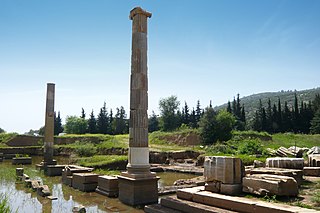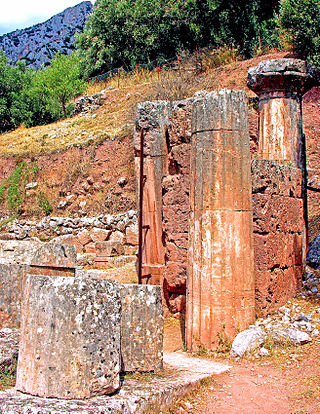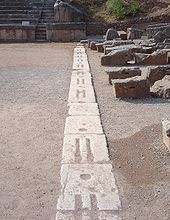
Delphi, in legend previously called Pytho (Πυθώ), was an ancient sacred precinct and the seat of Pythia, the major oracle who was consulted about important decisions throughout the ancient classical world. The ancient Greeks considered the centre of the world to be in Delphi, marked by the stone monument known as the Omphalos of Delphi (navel).

Olympia, officially Archaia Olympia, is a small town in Elis on the Peloponnese peninsula in Greece, famous for the nearby archaeological site of the same name. This site was a major Panhellenic religious sanctuary of ancient Greece, where the ancient Olympic Games were held every four years throughout Classical antiquity, from the 8th century BC to the 4th century AD. They were restored on a global basis in 1894 in honor of the ideal of peaceful international contention for excellence.

The Stoa of the Athenians is an ancient portico in the Delphic Sanctuary, Greece, located south of the Temple of Apollo. The southern side of the polygonal wall of the platform forms the north wall of the stoa. It was constructed c. 478 BC-470 BC during the early Classical period. The one-aisled stoa with Ionic colonnade opens toward the southeast. It was dedicated by the Athenians after the Persian Wars.

Claros was an ancient Greek sanctuary on the coast of Ionia. It contained a temple and oracle of Apollo, honored here as Apollo Clarius. It was located in the territory of Colophon, which lay twelve kilometers to the north, one of the twelve cities of the Ionian League. The coastal city Notion lay two kilometers to the south. The ruins of the sanctuary are now found north of the modern town Ahmetbeyli in the Menderes district of Izmir Province, Turkey.

The Dancers of Delphi, also known as the Acanthus Column, are three figures in high relief on top of an acanthus column found near the sanctuary of Pythian Apollo at Delphi. They are on display in the Delphi Archaeological Museum and were the inspiration for the first of Claude Debussy's Préludes.
The Lesche of the Knidians was a lesche, i.e. a club or meeting place, at the sanctuary of Apollo in Delphi. Today, it has been mostly destroyed; the only surviving parts are some architectural relics. It hosted two famous paintings by the famous painter Polygnotus the Thasian, namely the Capture of Troy and the Nekyia. It was built in the second quarter of the 5th century BC. Apparently it was a rectangular building, bearing a clerestory along its western side, and perhaps with a tripartite interior arrangement. In the 4th century, a wall was added along its southern side for placing ex votos.

The Gymnasium at Delphi is a building complex of the 4th century BC at Delphi, Greece, which comprised the xystus and the palaestra, along with its auxiliary buildings such as the changing rooms and baths. It was situated between the Sanctuary of Athena Pronaia and the fountain Castalia. Some remains of archaic buildings, discovered under the xystus, were possibly related to a sanctuary dedicated to Demeter and indicate the sanctity of the area from earlier times.

The Altar of the Chians was the altar of the Temple of Apollo at Delphi, dedicated by the people of Chios.

The Temple of Athena Pronaia was a temple at the ancient site of Delphi, in the Sanctuary of Athena Pronaia, a group of buildings comprising temples and treasuries as well as the famous Tholos of Delphi. There were in fact three successive temples built at the site. The earlier temples (38°28′49″N22°30′30″E), referred to as A and B, were built in the 7th and 6th centuries BC respectively and were made of porous stone; a third temple (38°28′49″N22°30′28″E) was built of limestone in the 4th century BC, although it is not certain that it actually was dedicated to Athena this time.

The tenth book of the work Description of Greece by the traveler Pausanias is dedicated to Phocis; its larger part constitutes a description of the sanctuaries and buildings of Delphi. His work constituted a precious aid to travelers and archaeologists who attempted to identify the monuments revealed by the excavations, although in some cases their identifications were not enough.

The stele of Prusias is one of the ex votos at the sanctuary of Apollo in Delphi, constructed in honour of king Prusias II of Bithynia.

The Portico of the Aetolians, known also as the Western Portico, is one of the largest buildings of Delphi, situated outside of the sacred precinct of the sanctuary of Apollo.
The Treasury of Cyrene was a building in the sanctuary of Apollo in Delphi. The treasury was possibly built as a token of gratitude for a large endowment of wheat offered to Delphi's inhabitants during a lean period.
The Megarian Treasury was a building situated within the sanctuary of Apollo in Delphi, to the north of the Siphnian Treasury along the Sacred Way. On its façade have been inscribed 26 inscriptions referring to the citizens of Megara, a fact which led to the secure identification of the monument.
Archaeological investigation in Delphi started in the second half of the 19th century, but it was not until 1892 when a systematic excavation began under the direction of Théophile Homolle and the French Archaeological School of Athens. The "Great Excavation" lasted 10 years and was concluded by the creation of the first museum on-site. In the years to follow, the site never ceased to be excavated and investigated. Several of the monuments were restored and new interpretations continue to see the light in the academic field.
The Halos was a round open space close to the temple of Apollo in Delphi, where ancient rituals were being performed.
Next to the Bull of the Corcyreans close to the entrance to the sanctuary of Apollo in Delphi lay a grandiose monument dedicated by the Arcadians, particularly the Tegeates.

Behind the column with the Dancers of Delphi was situated the Athenian Treasury, where was located the famous ex voto of Daochos, a long marble base where stood nine statues, eight of which represented members of Daochos' family and one a god, probably Apollo. Daochos II, son of Agias, a politician from Pharsalus and supporter of Macedonia, was a hieromnemon at the delphic sanctuary from 336 to 332 B.C. He dedicated the ex voto as a sign of honour to his prominent family.

The Treasury of the Thebans at Delphi was built in the Doric order and made entirely out of local limestone from the quarries of St. Elias close to the town of Chrisso. It was situated a few meters below the first turn of the Sacred Way, the processional route in the sanctuary of Apollo. It had been dedicated by the Thebans for their victory against the Lacedaemonians at Leuctra.

The modern town of Delphi is situated immediately west of the archaeological site of the same name. The town was created as a home for the population of Castro, which was relocated to allow for the excavation of the site of ancient Delphi. The importance of the twin locations grew to the point where Delphi has also been made the name of the modern-day municipality, which includes the communities of the Plaistos valley system as far south as the Gulf of Corinth. The name Delphi came from the Oracle of Delphi, which was anciently accepted as a purveyor of truth revealed by the god Apollo.















